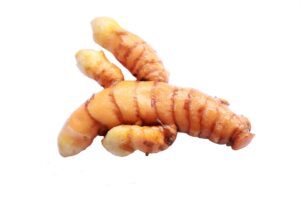How to Grow and Care for Turmeric Plants

Turmeric is a native of Southeast Asia and India, this herbaceous perennial plant belongs to the ginger family Zingiberaceae. The flavors of turmeric (rhizomes) have been used to flavor meats, salads, stews, and rice.
Turmeric has also been used in medicine, the florets are orange, white, pink, or yellow in color while the bracts can either be green, pink, white, burgundy, yellow, or multicolored. This perennial grows 3 to 4 feet tall with the same in diameter.
Although turmeric can grow outdoors year-round it is usually planted during the winter months and harvested the following year during the fall months to early winter. For more on growing turmeric in the home garden let’s take a closer look.
Turmeric planting location
Turmeric should be given full sunlight in the far North but in the Southern areas providing some afternoon, shade will be of great benefit.
Turmeric soil requirements
A well-drained soil that’s rich in compost with a pH that’s slightly acidic to slightly alkaline is ideal for your turmeric to thrive.
Turmeric water requirements
The soil of turmeric should always be moist, don’t allow the soil to dry out which can cause issues.
Turmeric Fertilizer requirements
Once a month give your turmeric a liquid feeding of an all-purpose fertilizer.
Growing turmeric in a pot
The pot size for your turmeric can be 14-18 inches, the potting mix or soil should be of high quality and well- drain. Plant one to two rhizomes and cover them with soil 2 inches below the soil level with the buds facing in the upward position.
Water rhizomes thoroughly and ensure that the soil is moist at all times and not waterlogged. Once a month give your turmeric a liquid feeding of an all-purpose fertilizer. In the autumn the roots can be harvested by digging them up.
Growing turmeric indoors
When growing turmeric indoors follow the planting guide as discussed in growing turmeric in a pot. Bring the pot inside and place it near a window that gets at least 6 hours of sunlight. Follow plant maintenance as laid out.

Harvesting turmeric
Seven to ten months after planting, your turmeric will be ready to harvest. Signs that your turmeric is ready to harvest are the leaves and stems turn brown and dry.
Dry turmeric
Wash your turmeric rhizomes thoroughly in fresh running water, cut the rhizomes into thin slices about 1/8″ thick. If drying in the oven place your turmeric on a baking sheet and set the heat at the lowest setting, if using a dehydrator lay pieces of turmeric single on the food rack.
The dehydrator should be set at 100-110°F, when turmeric is dried it will snap in half or crack. The process of drying will take about several hours. A food processor or blender will ground your turmeric to powder.
With the help of a mesh wire strainer, over a bowl begin to sift your ground turmeric, next pour this powder into an air-tight jar now store your turmeric in a cool dry place like your cupboard or kitchen pantry which can last for more than a year.
How to store turmeric?
Fresh turmeric can be stored in the fridge or freezer in Ziploc bags, before sealing the Ziploc bag remove all of the air. Unfreeze and use as needed by grating or slicing, the roots can also be ground into powder, dry, or boil.
The final word on how to grow turmeric
Enjoy the flavor of turmeric as you season your meats, stews, rice, or salads. This plant will excite your taste buds as you enjoy those delicious meals cooked right from your kitchen. So make turmeric a part of your backyard garden and join the many homeowners who are enjoying this awesome flavor.
About the author
Norman loves being in the garden, both at home and for his job....
he is 'Natures Little helper' being outdoors, growing his vegetables and flowers from an early age.
Now having spent over 22 years in the profession he want to give some of his knowledge to others...
his vast array of hints and tips you will find scattered over this site will help you no end growing plants in your garden.

We often use turmeric in cooking, especially as an addition to sauces.
But I didn’t think I would grow it myself. Now you gave me a great idea to try growing turmeric in a pot. That I will be able to transfer it inside if it gets too cold outside because I have already missed the best time to plant it outside.
Thank you for all the instructions and information that inspired me and will be very helpful in my upbringing.
Friendly greeting,
Nina
Nina, I am so happy to help, wishing you all the best with your turmeric.
Thank you so much for this informative article on growing turmeric. I live in a desert, so if I wanted to grow turmeric I’m assuming I should do it in a pot, like how you suggested. The soil here would always dry out because of the hot weather and the fact that it hardly ever rains except for once a year.
I am so happy to help and wishing you success as you grow your turmeric.
Great article on How to Grow and Gare for Turmeric Plants. (you might want to fix the mistake in your title, I think you meant Care)
My Dad just grew a heap of Tumeric this year. It is easy enough to grow and process, but I wondered what the health benefits of Tumeric are? I have heard it is really good for you, but I am not sure why.
You are welcome and thanks so much for your help, all the best to you and have a good day
Hi Norman,
At home, we usually use Tumeric when preparing curry. As you have pointed out, we also use it as medicine as a paste or in liquid form.
We do grow ours in pots on the staircase. However I never really know when it was ready for harvesting. We usually dig it out after a couple of months which amount to the 10 months you have talked about. I will now be observing the leaves for clearer guidance.
Thank you for this informative post on Tumeric.
You are welcome and I am so happy to help!!